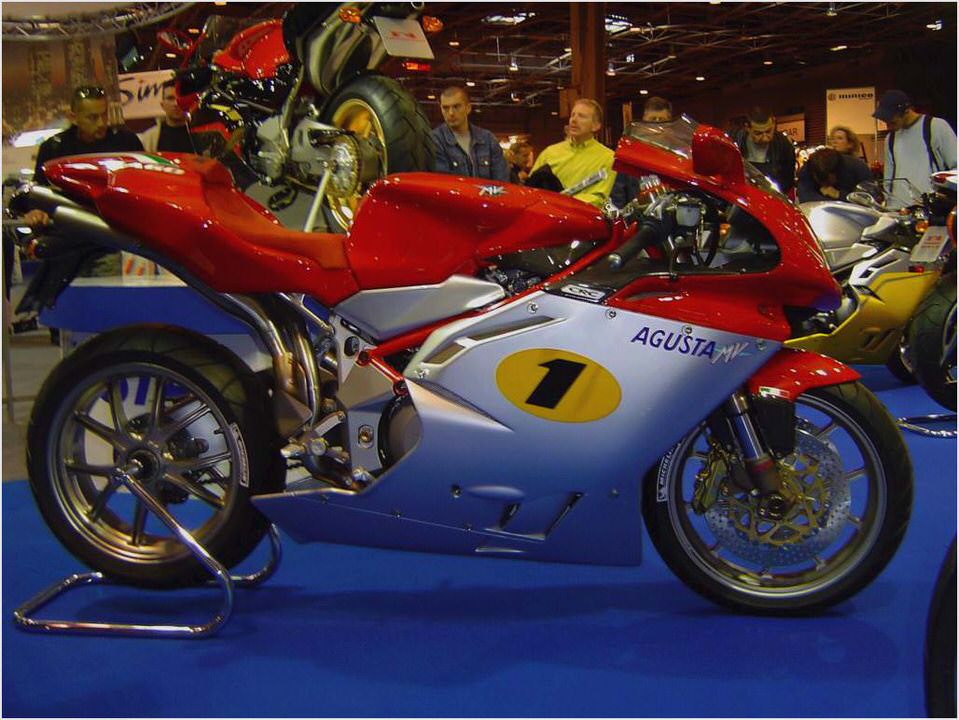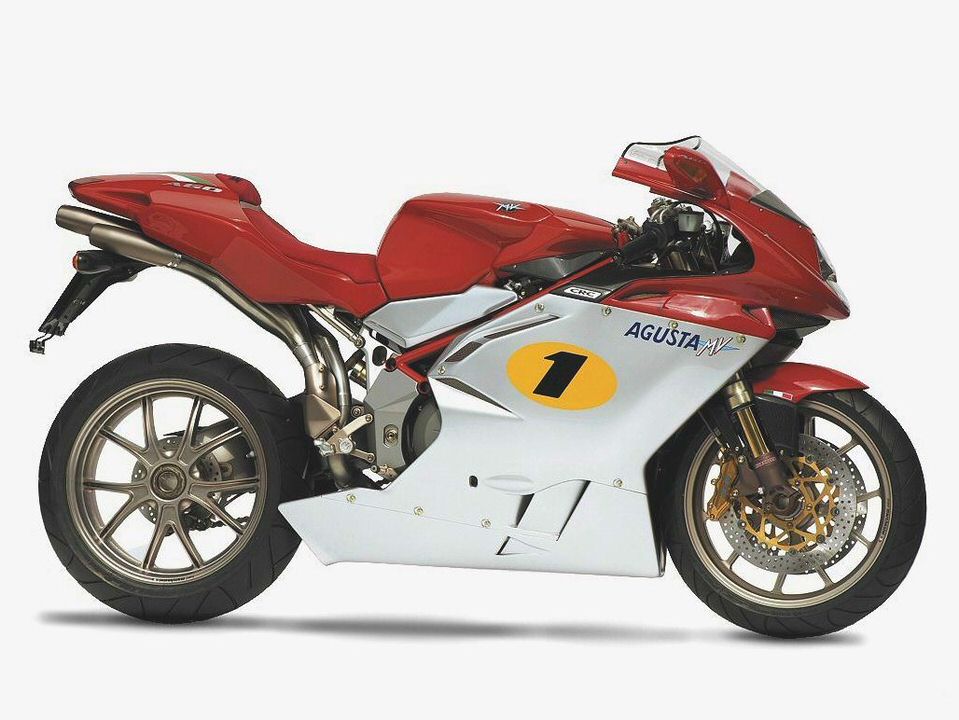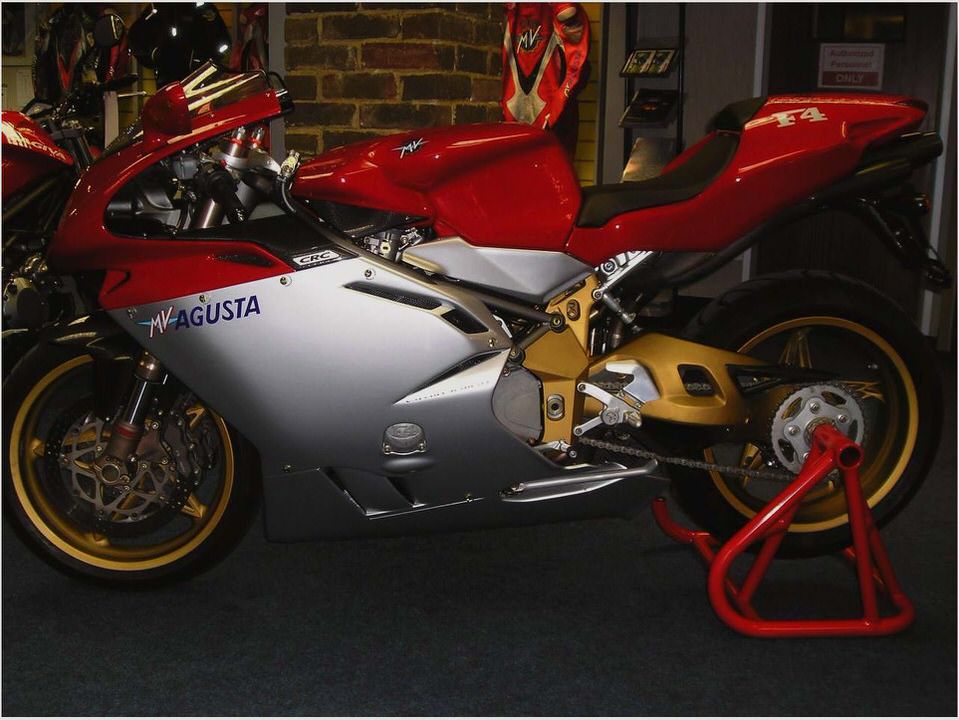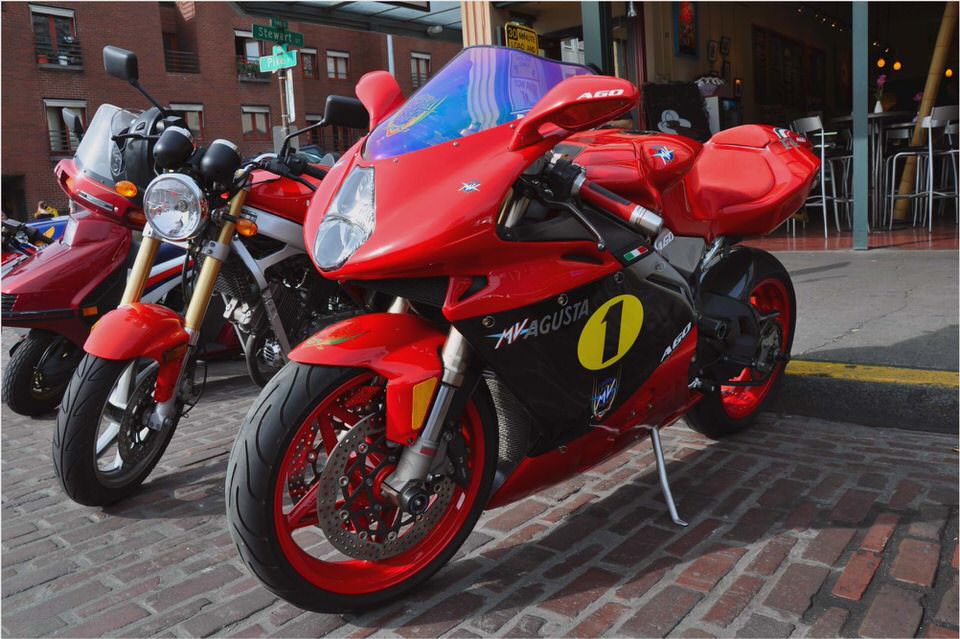
MV Agusta F4 1000 S Motorcycle Exclusive Ride
With the MV Agusta 1000 S motorcycle, Italy supersizes the world’s most desirable 750, giving Japan Inc.’s new literbikes real competition#151in terms of power and weight#151for not much more money. By Alan Cathcart.
Front Left View
Claudio Castiglioni on Tamburini’s Trophy Bike Castiglioni poses with Tamburini’s latest lust object, the F4 1000 S. We had a couple of questions.
With the F4 1000 S almost unchanged aesthetically from its now defunct 750 S predecessor, wasn’t it time to freshen its styling?
We always intended the styling of the MV F4 to remain essentially unchanged even in 1000cc form because we believe this is a timeless work of art [that] will be as desirable 10 years from now as the day it was launched#151just like the previous model Tamburini created for me, the Ducati 916. When you have a beautiful bike like either of these, you need to understand that you must evolve it, not throw it away and try to do something better, because you won’t succeed.
Look at Porsche. After years of manufacturing the legendary 911, it came up with the 928, which it intended to replace the 911, simply [because] it was ‘different’ and ‘modern.’ Eventually it had to pull the 911 out again, then develop it into the best-selling form it’s in today, 30 years after its birth. We have no intention of making the mistake Ducati has by creating the 999 instead of evolving the 916, which is a landmark design in motorcycle history. It’s a big mistake.
We’re the ones who will benefit, so I suppose I should thank them! But look why they’ve done it: The 999 has been built the way it is primarily with the intention of saving costs. But for this kind of motorcycle, which represents the dream of so many enthusiasts to own, small savings should not come into it.
We’re producing two-wheeled works of art at a price [that] allows customers to buy them in significant numbers, and enjoy their performance. That permits us enough profit to stay in business and continue developing them. So that’s why the F4 Mille has the same styling as the F4, but with subtle changes representing an ‘evoluzione’ of the existing model.
It’s the only proper route.
Will the new F4 become a volume production model, or a handbuilt limited-edition luxury bike?
We’ll produce a maximum of 7000 MV Agustas in any one year, split between F4 and Brutale models, depending on demand. I know the market is hungry for more, but there’s a physical limit to how many we can produce. We also don’t want to produce more. Look, Ferrari understands it must never increase production beyond a certain point, must never entirely satisfy demand.
If any motorcycle company can claim to be the Ferrari of the motorcycle world, rather than the Alfa Romeo or the Maserati, then it could only be MV Agusta. But I won’t make that claim yet. Manufacturing only a limited number of bikes each year, as we are now doing, is what stimulates the high level of inherent quality and the sophisticated technology of our products.
Variable induction, radial valves, let alone Tamburini’s unique styling and leading-edge chassis design. all these differentiate our products from those made in Japan. By limiting production, we can deliver the finest quality as well as high technology. That is what makes our motorcycles so desirable.
Front Left View Claudio Castiglioni on Tamburini’s Trophy Bike Castiglioni poses with Tam
When MV Agusta’s F4S debuted spectacularly at the 1997 Milan show, it was almost universally adored#151for its technical credentials as well as its Tamburini-penned design and styling.
But criticisms emerged when it finally reached the world’s back roads two years later. It wasn’t powerful enough (especially compared with Suzuki’s 118-horsepower GSX-R750), and it was comparatively heavy.
With the all-new F4 1000 S, that’s all changed. Because what MV Agusta has done in transforming its 750-class F4 into a literbike goes beyond near parity relative to the current Japanese literbikes’ performance. It maintained all the wanton desirability that made the F4S so appealing in the first place.
And all for around 21 grand.
I recently got a chance to ride a production-ready F4 Mille in the hills around the MV factory in Varese, Italy, and also on Pirelli’s test track at Vizzola Ticino, and was astounded at how good it is. As the owner of a 2000-spec F4S 750, I have a particular basis for making firsthand comparisons, and though the two bikes look nearly identical at first glance, they’re night and day in terms of performance.
They’re different ergonomically, too. The 1000 offers a higher degree of comfort thanks to its raised, reangled clip-ons and adjustable footpegs. You’d think the more upright stance would result in more bothersome windblast, but a taller screen with an upswept lip developed in the wind tunnel offers better protection and makes 100-plus-mph cruising much smoother.
Nice#151even if those stylish mirrors are just as useless as before.
Being somewhat comfortable is a good thing on a bike this powerful. MV claims 166 crankshaft horsepower for the bored and stroked F4S-based engine, a whopping 32 percent increase over the 750cc powerplant. There’s nearly 50 percent more torque, too, and from the saddle it feels every bit of that.
Bore and stroke for the new motor measure 76 x 55mm vs. the 750 engine’s 73.8 x 43.8mm numbers; so a little more bore, but a lot more stroke, which is presumably where the 1000 gets its impressive midrange and seamless, almost totally linear power delivery. There’s none of the layered delivery that you get with the Japanese literbikes, especially the Yamaha and Kawasaki machines, which are semipeaky in nature.
All this makes the 1000 S deceptively fast. You need to dramatically reprogram your perceptions to get a handle on just how quickly it actually accelerates. The way the MV builds power is intoxicating, and while you can rev it right to its 11,750-rpm power peak and brush the rev limiter without power tailing off, in real-world road use you’ll find yourself short-shifting at around 10,000 rpm#151which, by no coincidence, is where peak torque is delivered.
With essentially the same close-ratio gearbox as my 750 (which needs to be revved hard to make decent power), the big MV can be shifted well short of redline and still surf the fat part of the torque curve, gathering momentum Millennium Falcon-like right up to its factory-documented top speed of 180 mph.

Top speed and power delivery aside, it’s the way the big MV responds to everyday riding that really impresses. We’ve already mentioned the less-radical riding position. The engine is exceptionally smooth at all rev points, which means that despite a lighter crankshaft than the 750’s unit, MV must have gotten the balance factor just right.
Riding a high-strung sportbike through everyday traffic can be a pain, but the MV is quite docile. The engine is flexible and forgiving down low, though the clutch, which is a bit stiffer to handle the engine’s extra torque, can work the rider’s left hand pretty hard. Despite that, the new engine changes gears more sweetly than the 750’s, with less of a mechanical feel.
The only other problem I noticed was some excess heat from emerging from the 1000’s fairing, especially when I wore jeans for one ride around the city.
2004 Mv Agusta F4 1000s Front Left View
Still, it’s ironic that this new MV, possibly the most track-oriented of the new literbikes, is maybe the most user-friendly and ridable in terms of engine performance. It’s more GSX-R1000 than ZX-10R.
When I heard MV had adopted an electronic anti-engine-braking setup similar to the system on Yamaha’s M1 MotoGP bike, I was skeptical, mostly because that was the one thing I didn’t care for when I rode Carlos Checa’s ’03 racebike. Freewheeling into corners with zero engine braking aboard a 200-mph motorcycle wasn’t a lot of fun.
But I needn’t have worried, because the MV’s system#151which holds open the number-two cylinder’s valves depending on rpm, the rate of decrease of engine speed and throttle opening151worked wonderfully; there’s no rear-wheel chatter even if you get overenthusiastic with engine braking, and there’s no two-stroke-style freewheeling toward the apex, leading to the sense that the CPU is riding the bike, not you. Instead, there’s only a distinctive noise from around 5000 rpm on deceleration#151brrrrrm!#151to betray the fact that you have one cylinder’s valves stay open to reduce that rear-wheel chatter.
This is one reason the MV is so stable under the hard braking delivered by the six-piston Nissin calipers squeezing 310mm discs, a direct carry-over from the 750 F4. But there’s another reason: A special valve on the Sachs shock increases high-speed rebound damping to keep the back wheel from rising during hard stops. Repeated thundering down the main straight at Pirelli’s test track and squeezing the brake lever hard for the tight bends at either end failed to reveal any chink in this system.
It’s an added safety measure as well as a handling improvement that works without compromising the MV’s excellent ride quality, even on broken surfaces.
The 1000 S employs the same TIG-welded chrome-moly frame as the 750’s, but it now comes fitted with a fully adjustable 50mm Marzocchi fork rather than the 49mm Showa originally chosen by Tamburini. Although the steering-head angle has been relaxed a touch to 24.5 degrees (from 24), the bike’s handling remains peerless, with great turn-in making it easy to flick from side to side in chicanes or on a twisty set of street corners.
The use of chicane is appropriate, because what we have here is a sportbike with such impressive and satisfying performance that it begs to be ridden on the racetrack, where you can revel in its awesome engine performance and benchmark handling without fear of speed cameras or four-wheelers pulling out from side streets. That’s not to say the MV Mille isn’t also a surprisingly practical real-world streetbike, just that its true performance benefits over the 750 just do not become truly apparent until you take the machine out onto the racerack.
With total MV Agusta production limited by the number of four-cylinder engines the Varese factory can produce on a 24/7 triple-shift basis to around 7000 bikes a year, half of them 750 Brutales (the 7500 has been discontinued), the F4 1000 S’s price of just under $21,000 isn’t excessive, representing a roughly 35 percent premium when compared to such current mass-produced motorcycles as the Yamaha YZF-R1 or the Honda CBR1000RR.
The two days I spent with MV Agusta’s new 1000cc F4 S convinced me that this truly is the Ferrari of motorcycling, in performance as well as appearance. For the first time ever, we have a four-cylinder European streetbike able to live on competitive terms with the best of Japan Inc. in terms of performance, with added style, allure and history. Fans of Italian bikes have gotta like that!
For more info contact Cagiva USA at www.Cagivausa.com or (215) 830-3300.




- Riders Hill motorcycle destination and Suzuki, Aprilia, Moto Guzzi, MV…
- MV Agusta Rivale 800 Unveiled – Motorcycle…
- MV Agusta F4 Ago
- 2013 MV Agusta Brutale 1090RR Best Motorcycles 2014
- MV Agusta chillbike.co.za
